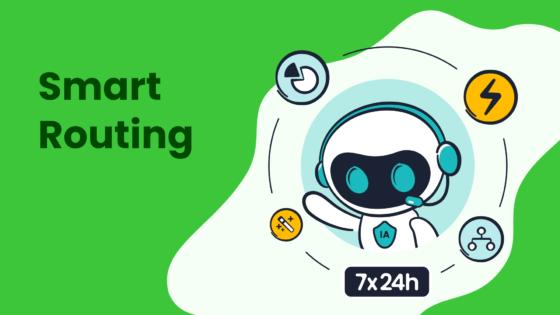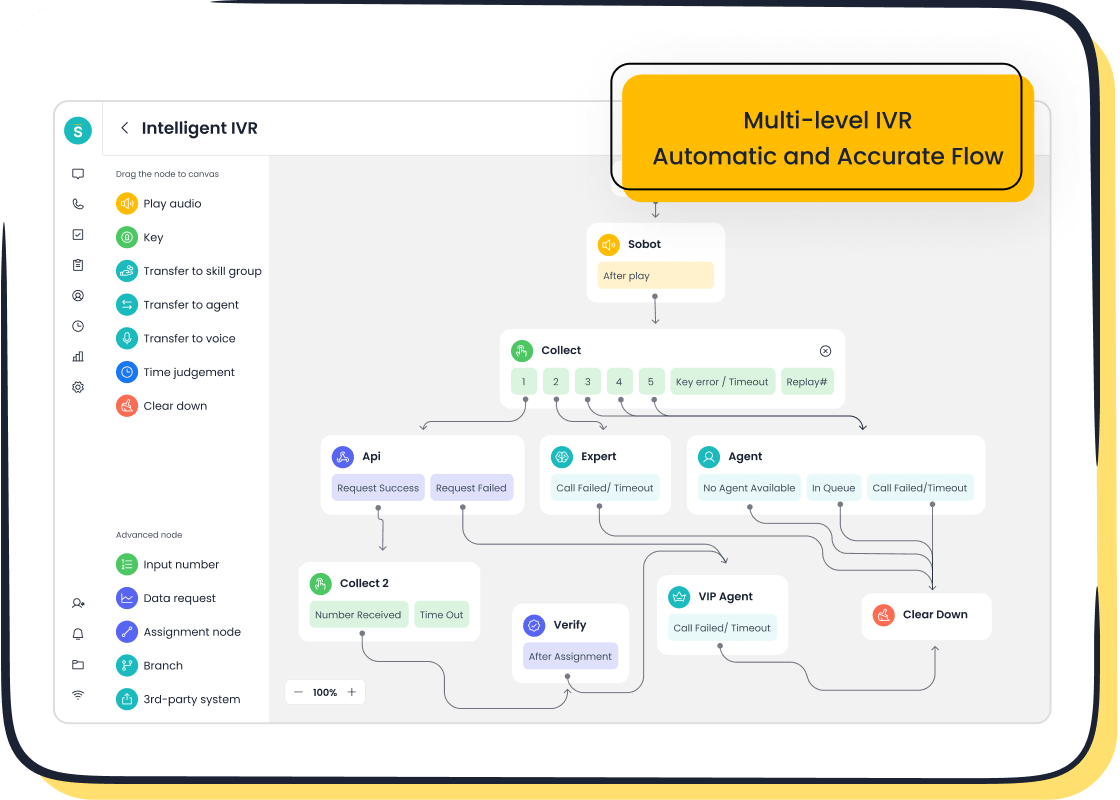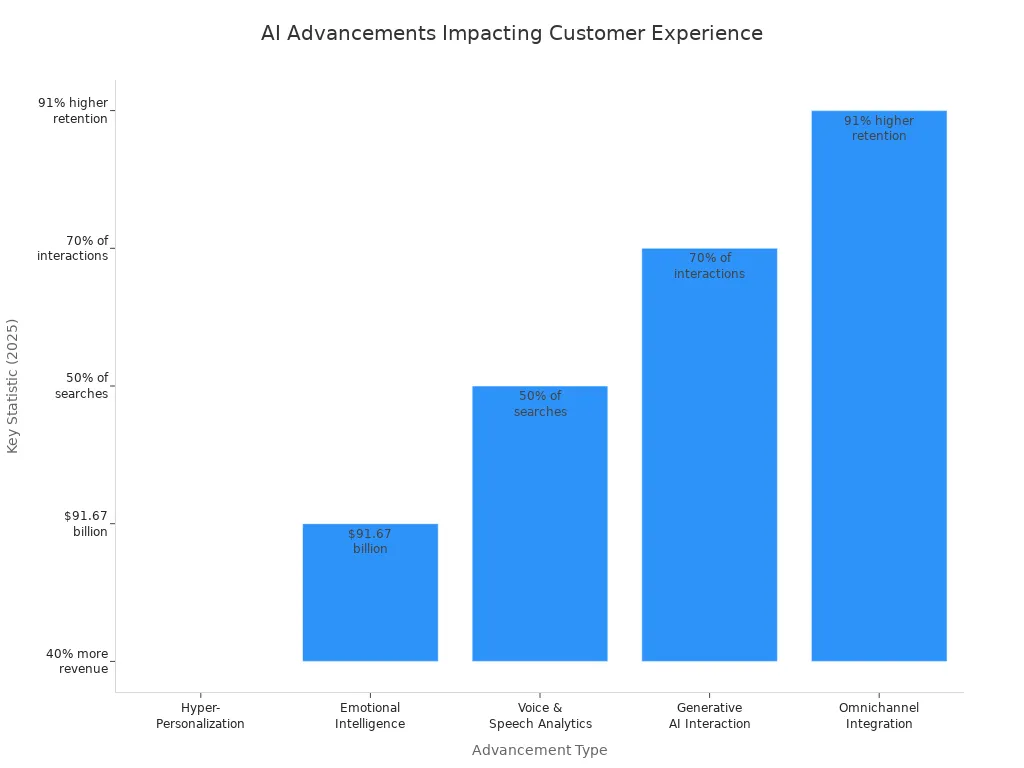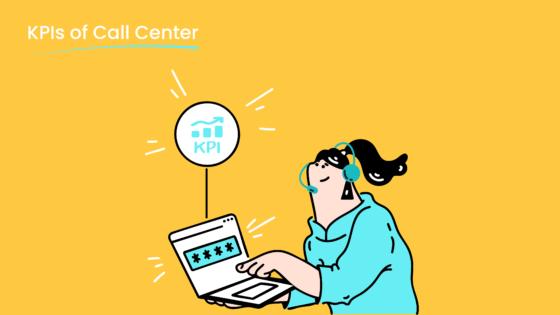Customer Satisfaction Predictions for the Year Ahead

Nearly half of all customers want a reply in less than four hours, and only 12% expect answers in 15 minutes or less. This shift shows how fast-paced customer satisfaction will become in 2025. You will see new trends shape your daily work in service and support.
| Trend | Description |
|---|---|
| Proactive Support | You must anticipate needs and solve problems before they grow. |
| AI-Driven Automation | Sobot AI can predict issues and streamline your service processes. |
| Omnichannel Experiences | Customers want seamless journeys across every channel, from chat to Sobot call center. |
| Advanced Personalization | People expect service tailored to their preferences. |
| Balance of AI and Human Touch | Automation helps, but empathy from agents remains essential. |
"By prioritizing your employees’ experiences, ensuring they feel valued, motivated, and engaged, they are more likely to provide exceptional service, creating a ripple effect that enhances customer satisfaction and fosters loyalty."
Sobot addresses these challenges with real-time analytics and sentiment analysis, helping you keep pace with rising expectations.
Technology & AI in Customer Experience

The world of customer experience is changing fast. You see new technology every day. These changes shape how you connect with customers and how you solve their problems. In 2025, digital transformation will drive most customer experience trends. You need to know how artificial intelligence, automation, and smart tools will help you deliver better service.
AI-Driven Service Trends
You notice that customer service trends now focus on speed, accuracy, and understanding. AI in customer experience helps you meet these goals. Many companies use AI to analyze customer emotions, predict needs, and personalize every interaction. This shift leads to higher satisfaction and loyalty.
Here is a table showing the latest advancements in artificial intelligence and their impact on customer experience trends in 2025:
| Advancement Type | Key Statistics |
|---|---|
| Hyper-Personalization | By 2025, hyper-personalized experiences are predicted to generate up to 40% more revenue for retailers than experiences that are not personalized. |
| 80% of consumers are more likely to purchase from a company that offers personalized experiences. | |
| AI-Driven Emotional Intelligence | The global market for emotional AI will reach $91.67 billion by 2025. |
| AI-powered emotion recognition can increase customer satisfaction by 40-50%. | |
| AI-Powered Voice and Speech Analytics | Voice search is projected to account for 50% of all searches by 2025. |
| Over 30% of businesses now use AI to handle customer calls, reducing average handle time (AHT) by up to 60%. | |
| Generative AI for Customer Interaction | By 2025, generative AI could handle up to 70% of customer interactions without human intervention, improving customer satisfaction by 30%. |
| The generative AI market will grow by 33% CAGR, hitting a market size of $13 billion by 2025. | |
| Omnichannel AI Integration | Businesses that adopt omnichannel strategies can expect to see a 91% higher year-over-year increase in customer retention rates. |

You can use AI to improve your customer experience in many ways:
- Real-time sentiment analysis lets you understand how customers feel during every interaction.
- AI-powered automation calculates customer satisfaction scores (CSAT) without manual surveys.
- Conversation summary analysis helps you train your team and improve responses.
- Intent categorization shows you what customers want, so you can fix common issues fast.
Sobot’s AI-powered solutions, like the voicebot and live chat, use these tools to help you deliver fast, accurate, and personal service. You can see how digital transformation makes your work easier and your customers happier.
Sobot Voice/Call Center Innovations
You want your call center to be efficient and reliable. Sobot’s Cloud Call Center uses AI in customer experience to make this possible. You get smart call routing, intelligent IVR, and a unified workspace for your agents. These features help you answer calls quickly and solve problems on the first try.

Here is a table showing the measurable outcomes from using Sobot’s voice and call center innovations:
| Outcome | Measurement |
|---|---|
| Sign-off rate | Increased by 35% |
| COD collection rate | Increased by 40% |
| Customer Satisfaction (CSAT) | Achieved 93% |
| Return on Investment (ROI) | 234% |
| Efficiency Improvement | 60% reduction in agent workload |
| Conversion Rate | Increased by 15% |
| Net Promoter Score (NPS) | Improved by 35% |
| Resolution Time | Less than 1 minute |
You see that Sobot’s call center helps you reduce agent workload by 60%. You also notice faster resolution times, often less than one minute. This means your customers get help right away. You can track every call, analyze data, and improve your team’s performance. Sobot’s system supports global numbers, encrypted data, and mobile access, so you can serve customers anywhere.
Sobot’s digital transformation tools let you connect voice, chat, and messaging in one place. You can use the WhatsApp Business API to reach customers on their favorite apps. You can also automate outbound calls and manage tickets with ease. These innovations help you keep up with customer experience trends and set new standards for service.
Generative AI & Chatbots
Generative AI and chatbots change how you deliver customer support. By 2025, AI will handle 70% of customer interactions. You can use chatbots to answer questions, solve problems, and even make personalized offers. Sobot’s AI-powered chatbot works 24/7, speaks multiple languages, and connects with your other systems.
Here are some ways generative AI and chatbots help you:
- An online bank can use AI to create loan offers based on each customer’s history.
- A telecom company can answer questions on its website, app, and social media at the same time.
- A SaaS business can save millions by automating technical support.
You see these results in your daily work:
- Support coverage runs around the clock.
- Response times drop to near-instant.
- Your team focuses on complex tasks while AI handles routine questions.
| Impact Area | Result |
|---|---|
| Support Coverage | Around-the-clock service |
| Response Time | Near-instant resolutions |
| Team Efficiency | Automation of routine tasks |
You also notice that companies using AI-driven support see a 30-50% increase in customer satisfaction. Businesses save $8 billion every year by using AI chatbots. Personalization in customer interactions leads to 5-15% more revenue. Error rates drop by 20% when you use AI for customer interaction.
Sobot’s chatbot and AI agent help you keep up with digital transformation and customer experience trends. You can automate ticketing, manage live chat, and provide seamless support across channels. This approach helps you meet rising expectations and deliver a better customer experience every time.
Tip: When you use Sobot’s AI-powered tools, you give your customers fast, personal, and reliable service. You also make your team’s job easier and more rewarding.
Personalization & Data-Driven Customer Satisfaction

Personalization stands at the heart of customer satisfaction in 2025. You see customers expecting every interaction to feel unique and relevant. Data-driven strategies help you understand each step of the customer journey. When you use these strategies, you create a seamless journey that builds loyalty and trust.
Hyper-Personalized Interactions
You notice that hyper-personalization changes how you connect with your customers. It uses data and smart technology to tailor every message, offer, and support interaction. This approach goes beyond using a customer’s name. It means you understand their preferences, habits, and needs at every stage of their journey.
- Sephora’s personalized experiences have transformed customer relationships and enhanced loyalty.
- The brand uses data-driven insights to tailor recommendations, leading to increased customer satisfaction.
- Customers feel recognized and appreciated, which fosters loyalty and advocacy for the brand.
You can follow this example by using customer data to create personalized service. When you recommend products based on past purchases or send reminders at the right time, you show customers that you value them. This makes each journey feel special. Hyper-personalization helps you stand out in a crowded market. It also increases customer satisfaction and loyalty.
Sobot’s omnichannel platform lets you deliver hyper-personalized service across voice, chat, and messaging. You can track preferences and behaviors, then use this information to improve every touchpoint. When you make each interaction personal, you turn regular customers into loyal fans.
Predictive Analytics
Predictive analytics gives you the power to anticipate what your customers need before they ask. You use advanced algorithms and machine learning to spot trends and patterns in customer behavior. This helps you act early and solve problems before they grow.
- Predictive analytics allows businesses to proactively resolve issues by identifying trends and patterns in customer behavior.
- This approach enables timely and personalized support, enhancing overall customer satisfaction.
- By analyzing customer interaction data, businesses can forecast behavior and preferences, allowing them to address potential issues before they escalate.
- AI can detect signals of customer frustration in real-time, enabling proactive support.
- Advanced statistical algorithms and machine learning are used to forecast customer behaviors and preferences, allowing support teams to anticipate needs and enhance satisfaction.
- Predictive analytics enhances decision-making and customer experience, leading to improved satisfaction and business growth.
- Predictive analytics utilizes customer and employee data to forecast behaviors, helping businesses to anticipate and resolve issues proactively.
You can use predictive analytics to improve customer satisfaction scores. For example, if you see that a customer often contacts support after a new product launch, you can reach out first with helpful tips. This proactive approach makes the journey smoother and builds trust. You also reduce the risk of negative reviews or lost sales.
Sobot’s analytics tools help you monitor every step of the journey. You can see which channels customers use most and what issues they face. This lets you adjust your service and offer support where it matters most. Predictive analytics turns data into action, helping you stay ahead of customer needs and trends.
Responsible Data Use
Responsible data use is key to building trust in every customer journey. Customers want to know that you handle their information with care. You must be transparent about how you collect, store, and use data. This openness helps you earn trust and loyalty.
- Transparency in data handling fosters trust, as customers feel secure sharing their information. A survey indicated that 79% of American consumers are concerned about data handling, and ethical practices can alleviate these concerns.
- Adhering to laws like GDPR and CCPA protects consumer rights and avoids penalties, enhancing trust.
- Ethical data practices lead to higher quality data, which supports informed decision-making and builds trust in the insights derived.
- Strong security measures protect sensitive information, maintaining customer trust and brand integrity.
- Scrutinizing algorithms for biases prevents unfair treatment and fosters accountability, enhancing customer trust.
- Ongoing training on data handling practices ensures employees understand their responsibilities, which is crucial for maintaining customer trust.
- Be open and transparent about data usage, making pledges about data handling.
- Empower customers with control over their data, providing choices about what they share.
- Integrate privacy into core products and foster a corporate culture that values customer data.
You can build trust by giving customers control over their data. Let them choose what information they share and explain how you use it. Make privacy a core part of your products and services. When you follow these best practices, you protect your brand and create a safe journey for every customer.
Sobot’s solutions support responsible data use with strong security and compliance features. You can assure your customers that their data stays safe at every step of the journey. This commitment to privacy and ethics helps you build long-term relationships and drive customer satisfaction.
Tip: When you combine hyper-personalization, predictive analytics, and responsible data use, you create a journey that delights customers and earns their trust. These trends will shape the future of customer satisfaction in 2025 and beyond.
Automation & Human Touch
Balancing Automation
You see automation changing the way you deliver customer service experience. Many customer service trends in 2025 focus on using technology to make your work easier. You can use automation for routine tasks, such as answering common questions or processing simple requests. This lets your team spend more time on complex issues. When you design chatbots to feel personal, you help customers feel valued. Sentiment analysis helps you know when to transfer a customer to a human agent. You should always make it easy for customers to reach a person for sensitive problems. Training and empowering your agents gives them the skills to solve issues quickly. You need to monitor both automated systems and human agents to keep improving your customer support.
Tip: Use automation for speed and efficiency, but keep human agents ready for empathy and problem-solving.
Here is a simple way to balance automation and human touch:
- Use technology for routine tasks.
- Make automated interactions feel personal.
- Let customers reach human agents for complex issues.
- Train agents with AI tools.
- Monitor and improve both systems.
Human Agents in Service
Human agents play a key role in customer service experience. You rely on them to solve complex problems and build trust. Automated systems work well for simple tasks, but they struggle with issues that need judgment or empathy. Human agents adapt to each customer’s needs and show understanding.
| Aspect | Human Agents | Automated Systems |
|---|---|---|
| Problem-Solving | Excel in complex problem-solving | Struggle with complex queries |
| Emotional Intelligence | Provide empathetic support and build trust | Lack emotional understanding |
| Flexibility | Adapt to unique customer needs and situations | Rely on predefined responses |
You see that human agents make a difference when customers face difficult problems. They listen, respond with care, and find solutions that fit each situation.
Hybrid Support Models
Hybrid support models combine automation and human agents. You get the best of both worlds. Automation handles routine questions fast. Human agents solve complex problems and offer empathy. This approach improves efficiency and customer satisfaction. You can handle both simple and complicated inquiries.
- Improved efficiency
- Enhanced customer satisfaction
- Ability to handle both routine and complex inquiries effectively
You may face challenges with hybrid models. These include complexity in design, integration barriers, high computational costs, and data quality issues. You need to plan carefully and choose the right tools. When you do, you create a customer service experience that meets the needs of every customer.
Note: Hybrid support models help you keep up with customer service trends and deliver better results in 2025.
Omnichannel Engagement with Sobot
Unified Customer Experience
You want your customers to have a smooth journey, no matter how they reach out. Sobot’s omnichannel solution brings all your communication channels together. You can manage chat messages, calls, and tickets from one desk. This unified workspace uses AI to help you respond faster and more accurately. The system supports different languages, so you can serve customers from around the world.
Here is how Sobot’s omnichannel solution works:
| Feature | Description |
|---|---|
| Seamless Integration | Connects all your channels in one place. |
| Immediate Solutions | Delivers quick, personalized answers to customer questions. |
| Real-time Monitoring | Lets you track and manage service quality as it happens. |
You see the benefits in real life. Samsung used Sobot to unify its customer experience. The company improved agent efficiency by 30% and reached a 97% customer satisfaction rate. Customers got help faster, and agents had all the information they needed in one place. This shows how a unified customer experience can boost loyalty and keep customers coming back.
Proactive & Self-Service Support
You can help your customers before they even ask for it. Sobot’s platform uses AI to predict what your customers might need. You can send alerts, offer tips, or answer questions before problems grow. This proactive customer service reduces call volumes and helps your team focus on complex issues.
Try these strategies to improve customer support:
- Use predictive analytics to spot issues early.
- Send automated alerts to keep customers informed.
- Reach out after important interactions.
- Give customers self-service tools like FAQs and video guides.
- Collect feedback to keep improving.
Many companies see big results. For example, Copa Airlines cut its support case volume by 40% with proactive service. Self-service options let 81% of customers solve problems quickly. This saves time and keeps satisfaction high. You can learn more about Sobot’s approach at Sobot Omnichannel Solution.
Real-Time Multichannel Insights
You need to know what your customers feel and want right now. Sobot gives you real-time insights from every channel. You can see feedback from chat, calls, and social media all in one place. This helps you spot trends and respond fast.
- Real-time insights show you how customers feel on each platform.
- You can adjust your service based on what customers say.
- Analyzing feedback helps you improve your communication and build loyalty.
With Sobot, you stay ahead of customer needs. You can make quick changes to your service and keep your customers happy. This approach will shape customer engagement and customer experience in 2025.
Trust, Privacy & Ethics in Customer Service
Building Customer Trust
You build customer trust by making every interaction relevant, real, and relatable. When you tailor conversations to meet changing needs, you show customers that you care. Authenticity and empathy help you form stronger relationships. You also need to adapt your communication style to match what customers prefer.
Here are three key strategies to build trust in digital customer service:
- Be relevant: Adjust your approach to fit each customer’s needs.
- Be real: Show genuine care and understanding.
- Be relatable: Communicate in a way that feels natural to your customers.
Customers expect seamless experiences across all channels. Omnichannel connections let them move easily between online and in-store service. Security and convenience matter, too. Efficient transactions boost loyalty for 91% of people. Customer-centered design reduces friction and keeps users coming back. Most shoppers want self-service options, with 87% expecting brands to offer these tools.
Data Privacy Standards
You must protect customer data to maintain trust. In 2025, new laws and regulations set high standards for privacy in customer support. You need to follow rules like the General Data Protection Regulation (GDPR) and the Digital Services Act. These laws require you to get explicit consent, notify about breaches quickly, and give customers control over their data.
| Law/Regulation | Key Requirements |
|---|---|
| General Data Protection Regulation | Explicit consent, breach notification within 72 hours, rights to access and erase data |
| Digital Services Act | Transparency in content moderation, notice-and-action for illegal content |
| State Privacy Laws | Data protection assessments, privacy officers, limits on data collection |
You should use strong encryption to protect information. Regular privacy audits help you stay compliant. Training your team on privacy standards helps everyone recognize risks and keep data safe.
Ethical AI Practices
You use AI to improve customer experience, but you must do so ethically. Customers want to know when they interact with AI systems. You should be transparent about how AI works and how you use customer data. Regular audits help you find and fix any biases in your AI tools.
Best practices for ethical AI in customer service trends include:
- Transparency: Always inform customers when AI is involved.
- Privacy protections: Safeguard all customer data.
- Fairness: Check your AI for bias and correct it.
- Accountability: Make sure someone is responsible for AI actions.
- Continuous improvement: Update AI systems based on feedback and new challenges.
You can also create ethical guidelines for your team and train them on responsible AI use. These steps help you build trust and deliver better customer support in 2025.
Steps to Boost Customer Satisfaction in 2025
Invest in Smart Solutions
You can boost customer satisfaction in 2025 by investing in smart solutions that match new trends. Many brands now use voice recognition technology to make digital platforms easier to use. This technology can increase user engagement by 20%. Integrated customer communities help you connect with your audience, raising engagement by 21% and lowering acquisition costs by 18%. Blockchain technology keeps transactions secure, which reduces fraud by 40% and increases trust by 30%. AR and VR tools make experiences more interactive, boosting engagement by 40% and improving conversion rates by 25%. Predictive analytics lets you spot problems early, leading to a 20% drop in service issues and a 30% rise in loyalty. Mobile-first strategies, like those used by Starbucks, make it easy for customers to reach you anywhere.
Sobot’s all-in-one contact center brings these smart solutions together. You get voice recognition, predictive analytics, and a mobile-friendly platform. This helps you deliver a seamless customer experience and keeps your customer engagement high.
Upskill Service Teams
You need skilled teams to deliver great customer satisfaction. When you train your employees, they handle complex issues better and work more efficiently. A survey by PwC found that 73% of consumers see customer experience as a key factor in their buying choices.
| Benefit | Description |
|---|---|
| Improved CSAT and Net Promoter Scores | Upskilling leads to higher customer satisfaction scores. |
| Lower average handle times | Employees become more efficient in resolving customer issues. |
| Reduced turnover and recruitment costs | Engaged employees are less likely to leave, saving costs. |
Upskilling your team means they can use new tools, like Sobot’s AI-powered workspace, to solve problems faster. This leads to better retention and a stronger customer service strategy.
Act on Customer Feedback
You should always listen to your customers. Collect feedback at every stage of their journey. Use surveys like CSAT and NPS, feedback forms, and social media to gather insights. Mix both numbers and stories to get a full picture. Sort feedback by topic or urgency, look for patterns, and measure how often issues come up. Dive deeper into specific comments when needed.
Engaging users in the product development process builds trust and long-term engagement. When users see continuous improvements based on their input, they are more likely to remain active, engaged advocates.
Sobot’s analytics tools help you track and act on customer feedback in real time. When you respond quickly and make changes, you show customers that you value their opinions. This approach drives continuous improvement and keeps your customer satisfaction scores high.
You see customer satisfaction in 2025 shaped by new trends and technology. Research shows 89% of consumers return for good experiences, and 96% say service drives loyalty. Review your current strategies and look for ways to improve. Use clear goals, teamwork, and smart tools to stay ahead. Explore Sobot’s solutions to keep your business agile, innovative, and focused on your customers.
FAQ
What is the biggest customer service trend for 2025?
You will see AI-driven automation shape customer satisfaction. Companies use AI to predict needs and personalize every customer journey. This trend helps you deliver faster, more accurate support. Research shows 70% of customer interactions may use AI by 2025. Source
How does Sobot improve customer satisfaction?
Sobot gives you an all-in-one platform for voice, chat, and ticketing. You can manage every customer experience from one place. Sobot’s AI tools help you answer questions quickly and personalize each customer journey. Samsung improved agent efficiency by 30% using Sobot.
Why is omnichannel engagement important for customer experience?
Omnichannel engagement lets you connect with customers on their favorite channels. You provide a seamless customer journey, which boosts customer satisfaction. Companies using omnichannel strategies see a 91% higher retention rate. Source
How can you balance automation and the human touch in customer service?
You use automation for routine tasks and let human agents handle complex issues. This balance improves customer satisfaction. Sobot’s hybrid support model helps you deliver fast answers and real empathy during every customer journey.
What role does data privacy play in customer satisfaction?
Data privacy builds trust in every customer experience. You must protect customer data and follow privacy laws. Sobot uses strong security and compliance features. Customers feel safer and more satisfied when you respect their privacy during the customer journey.
See Also
Best 10 Customer Feedback Tools to Use in 2024
2024's Leading Customer Support Software Solutions Ranked
Enhancing Productivity with AI-Driven Customer Service Tools
